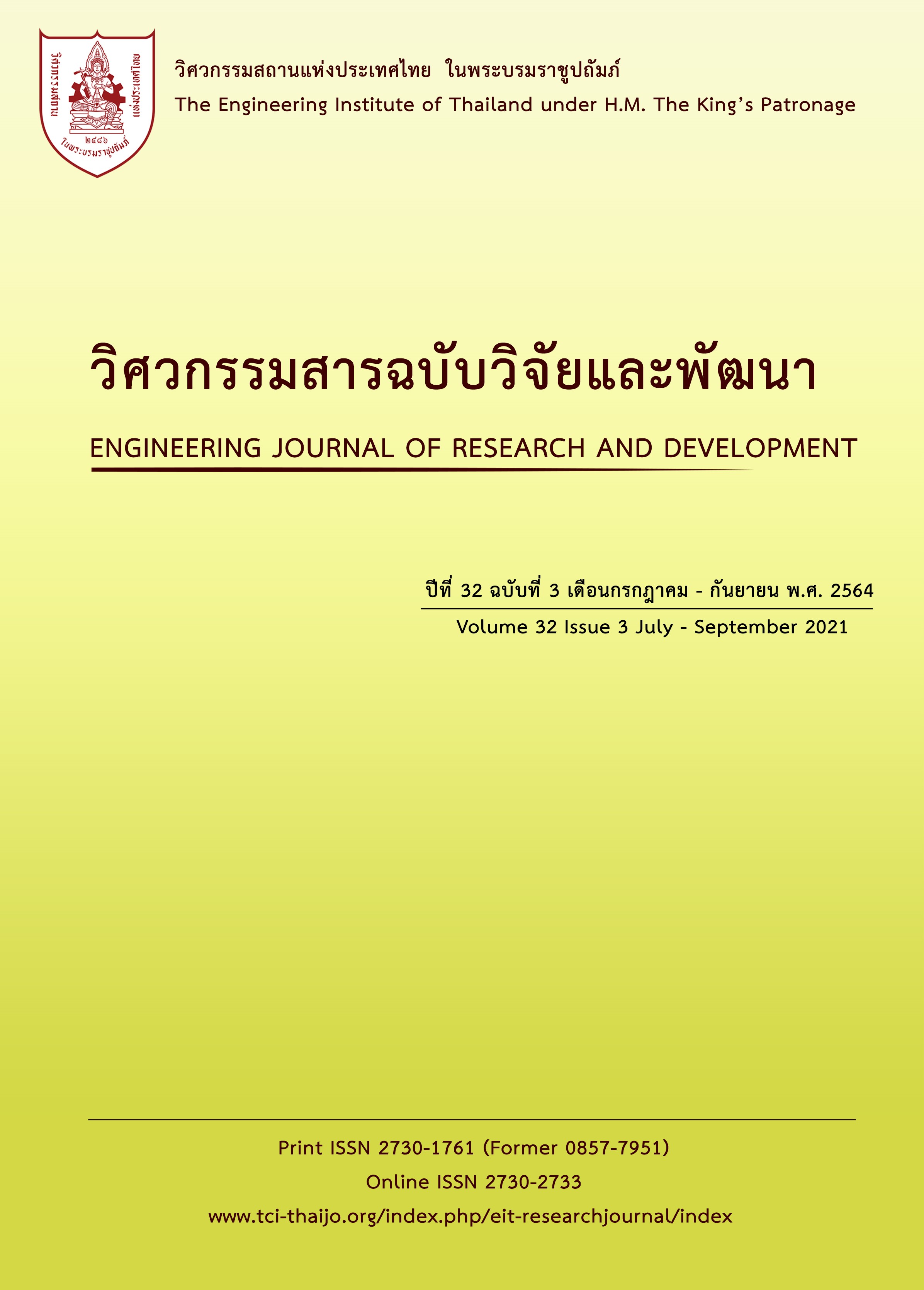การวิเคราะห์ปัญหาความเค้นใน 2 มิติด้วยวิธีสมูทไฟไนท์เอลิเมนต์จากการสร้างเอลิเมนต์รูปสี่เหลี่ยมใด ๆ แบบ 4 ส่วนย่อย
Main Article Content
บทคัดย่อ
การวิเคราะห์สมูทไฟไนท์เอลิเมนต์ซึ่งนำเสนอในงานครั้งนี้ ใช้หลักการแบ่งเอลิเมนต์ออกเป็นโดเมนสม่ำเสมอย่อยหลาย ๆ โดเมนภายในเอลิเมนต์ โดเมนสม่ำเสมอที่ใช้นี้เป็นเอลิเมนต์ทรงเหลี่ยมสี่หน้าด้านไม่เท่าที่ได้มาจากการกำหนดตำแหน่งแบบสุ่มด้วยค่า ในรูปอัตราส่วนของความยาวด้าน ซึ่งกำหนดให้มีค่าเท่ากันจำนวน 3 ช่วง คือ 0.2-0.3, 0.3-0.4 และ 0.4-0.5 สนามความเครียดสม่ำเสมอถูกสร้างขึ้นมาจากหลักการของ gradient smoothing เพื่อกระจายความเครียดตลอดทั้งโดเมนสม่ำเสมอย่อย หลักการความสมมาตรของโดเมนสม่ำเสมอย่อยถูกนำมาประยุกต์ใช้ในการสร้าง “Semi-unit cell” เพื่อทำให้เกิดความต่อเนื่องตลอดทั่วทั้งขอบเขตที่พิจารณา ปัญหาตัวอย่างความเค้นในระนาบ 2 มิติเป็นคานยื่นปลายรับแรงกระทำซึ่งมีการกระจายตัวของแรงเป็นรูปพาราโบลาในแนวดิ่งที่ปลายคาน เพื่อวิเคราะห์ค่าการเปลี่ยนตำแหน่งที่ปลายคาน ความเค้นตั้งฉากและความเค้นเฉือนตลอดความลึกของหน้าตัดที่ระยะความยาวกึ่งกลางคาน โครงตาข่ายที่ใช้มีจำนวนเท่ากับ 16x4, 24x6, 32x8, 40x10 และ 48x12 ตามลำดับ ณ ระดับที่ และจำนวนของโครงตาข่ายมีค่ามากที่สุดนั้น ความแตกต่างของการเปลี่ยนตำแหน่งที่ปลายคานของการวิเคราะห์เปรียบเทียบกับค่าที่ได้ทางทฤษฎีมีค่าเป็นร้อยละ 0.78 ความแตกต่างของความเค้นตั้งฉากมีค่าเป็นร้อยละ 0.04 และความแตกต่างของความเค้นเฉือนในระนาบมีค่าเป็นร้อยละ 1.52 ตามลำดับ
Article Details
บทความที่ได้รับการตีพิมพ์เป็นลิขสิทธิ์ของวารสารวิศวกรรมสารฉบับวิจัยและพัฒนา วิศวกรรมสถานแห่งประเทศไทย ในพระบรมราชูปถัมภ์
References
Bathe K-J. Finite element procedures, Prentice hall. New Jersey. 1996.
Zienkiewicz OC, Taylor RL, Zhu JZ. The finite element method: its basis and fundamentals: Elsevier; 2005.
Hughes TJ. The finite element method: linear static and dynamic finite element analysis, Courier Corporation, 2012.
Liu, G.; Trung, N.T. Smoothed Finite Element Methods, CRC Press: Boca Raton, FL, USA, 2010.
Liu, G.R.; Dai, K.Y.; Nguyen, T.T. A smoothed finite element method for mechanics problems. Comput. Mech. 2007, 39, pp.859–877.
Dai K, Liu G, Nguyen T. An n-sided polygonal smoothed finite element method (nSFEM) for solid mechanics. Finite elements in analysis and design. 2007, 43(11-12), pp.847-60.
Liu G, Nguyen-Xuan H, Nguyen-Thoi T, Xu X. A novel Galerkin-like weak form and a superconvergent alpha finite element method (SαFEM) for mechanics problems using triangular meshes. Journal of Computational Physics. 2009, 228(11), pp.4055-87.
Liu G, Zhang G. A normed G space and weakened weak (W2) formulation of a cell-based smoothed point interpolation method. International Journal of Computational Methods, 2009, 6(01), pp.147-79.
Hamrani A, Habib SH, Belaidi I. CS-IGA: A new cell-based smoothed isogeometric analysis for 2D computational mechanics problems. Computer Methods in Applied Mechanics and Engineering, 2017, 315, pp.671-690.
Wang D, Zhang H, Xuan J. A strain smoothing formulation for NURBS-based isogeometric finite element analysis. Science China Physics, Mechanics and Astronomy. 2012, 55(1), pp.132-140.
Bordas SP, Rabczuk T, Hung N-X, Nguyen VP, Natarajan S, Bog T, et al. Strain smoothing in FEM and XFEM. Computers & structures. 2010, 88(23-24), pp.1419-1443.
Nguyen‐Xuan H, Nguyen‐Thoi T. A stabilized smoothed finite element method for free vibration analysis of Mindlin–Reissner plates. Communications in Numerical Methods in Engineering. 2009, 25(8), pp.882-906.
Dai K, Liu G. Free and forced vibration analysis using the smoothed finite element method (SFEM). Journal of Sound and Vibration. 2007, 301(3-5), pp.803-820.
Natick, MATLAB. 9.7.0.1190202 (R2019b). Massachusetts, The MathWorks Inc.,2018.
Felippa CA. Introduction to finite element methods (Lecture note). University of Colorado. 2004.
Liu G-R. Meshfree methods: moving beyond the finite element method, Taylor & Francis, 2009.
Chen JS, Wu CT, Yoon S, You Y. A stabilized conforming nodal integration for Galerkin mesh‐free methods. International journal for numerical methods in engineering, 2001, 50(2), pp.435-466.
Liu G. A generalized gradient smoothing technique and the smoothed bilinear form for Galerkin formulation of a wide class of computational methods. International Journal of Computational Methods. 2008, 5(02), pp.199-236.
Timoshenko S, Goodier J. Theory of Elasticity, 3rd ed, McGraw-Hill. New York. 1970.

